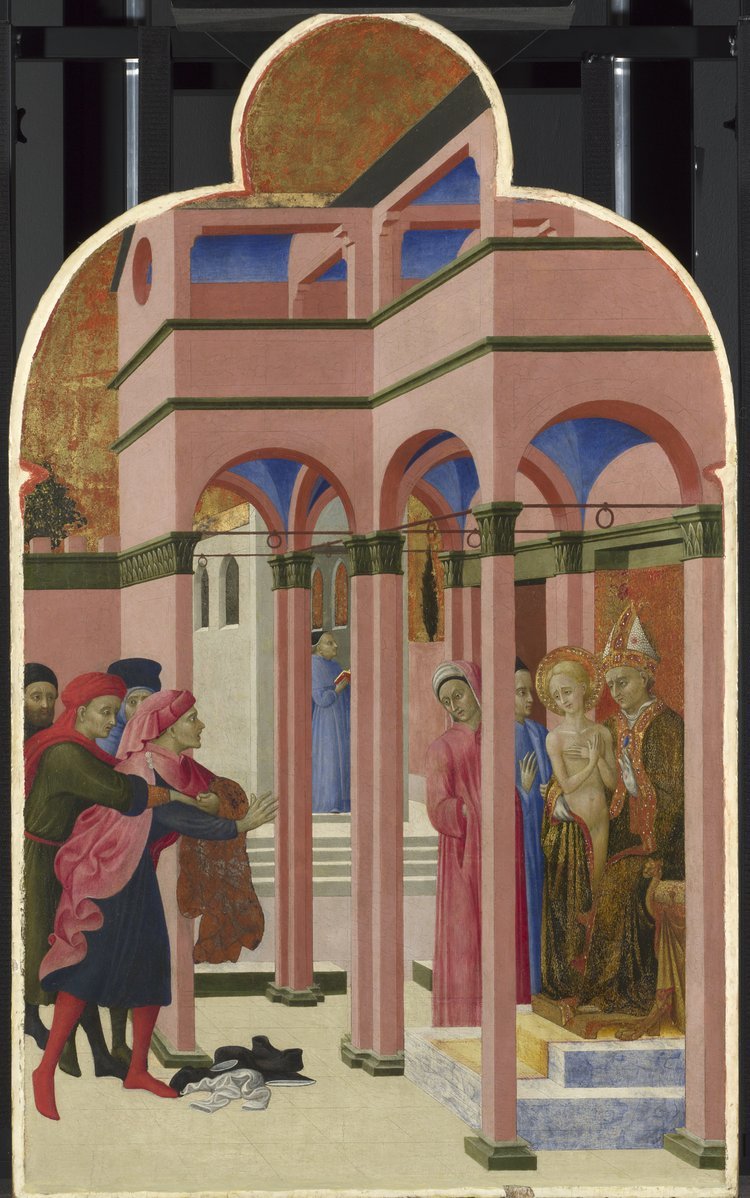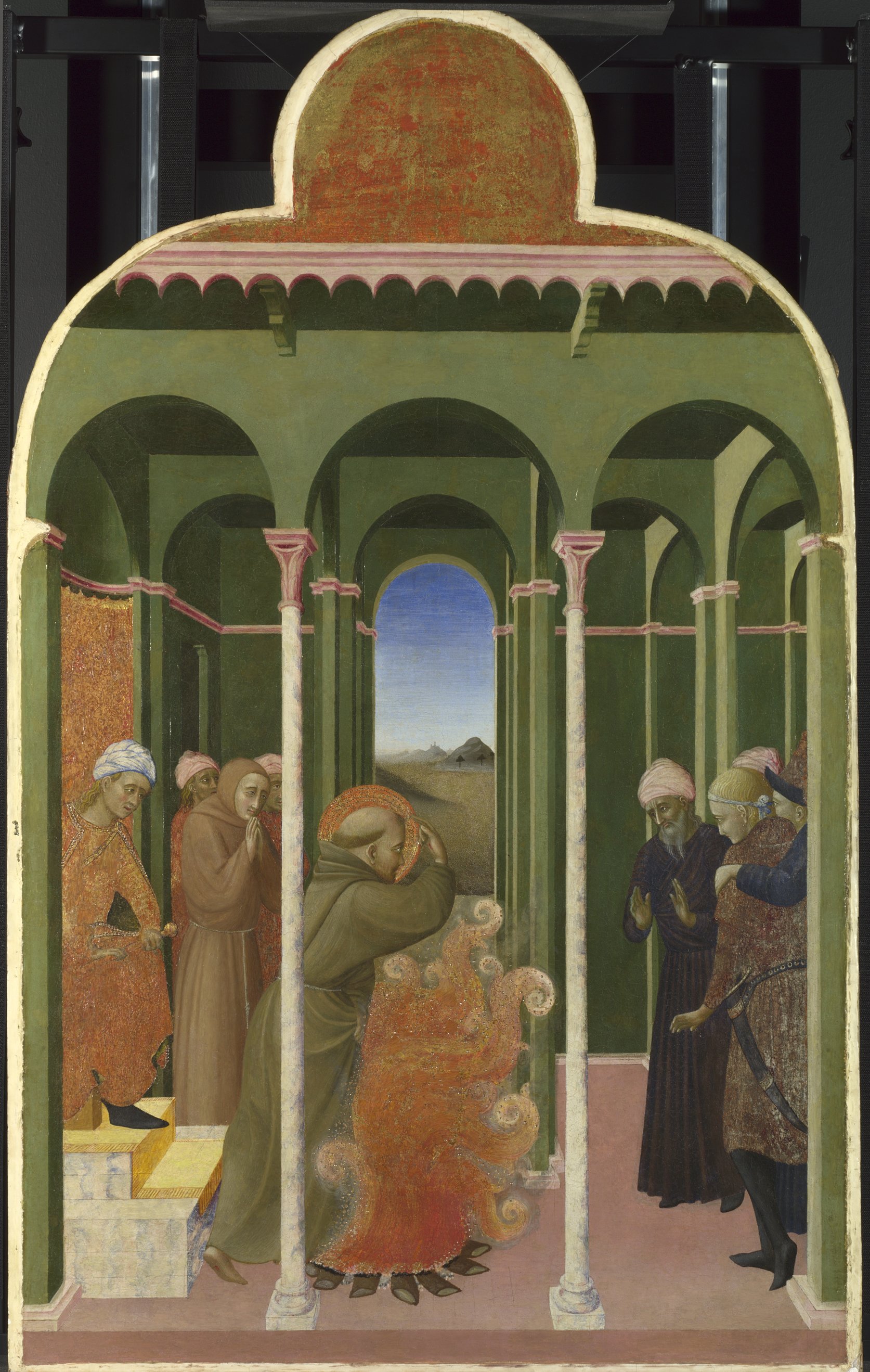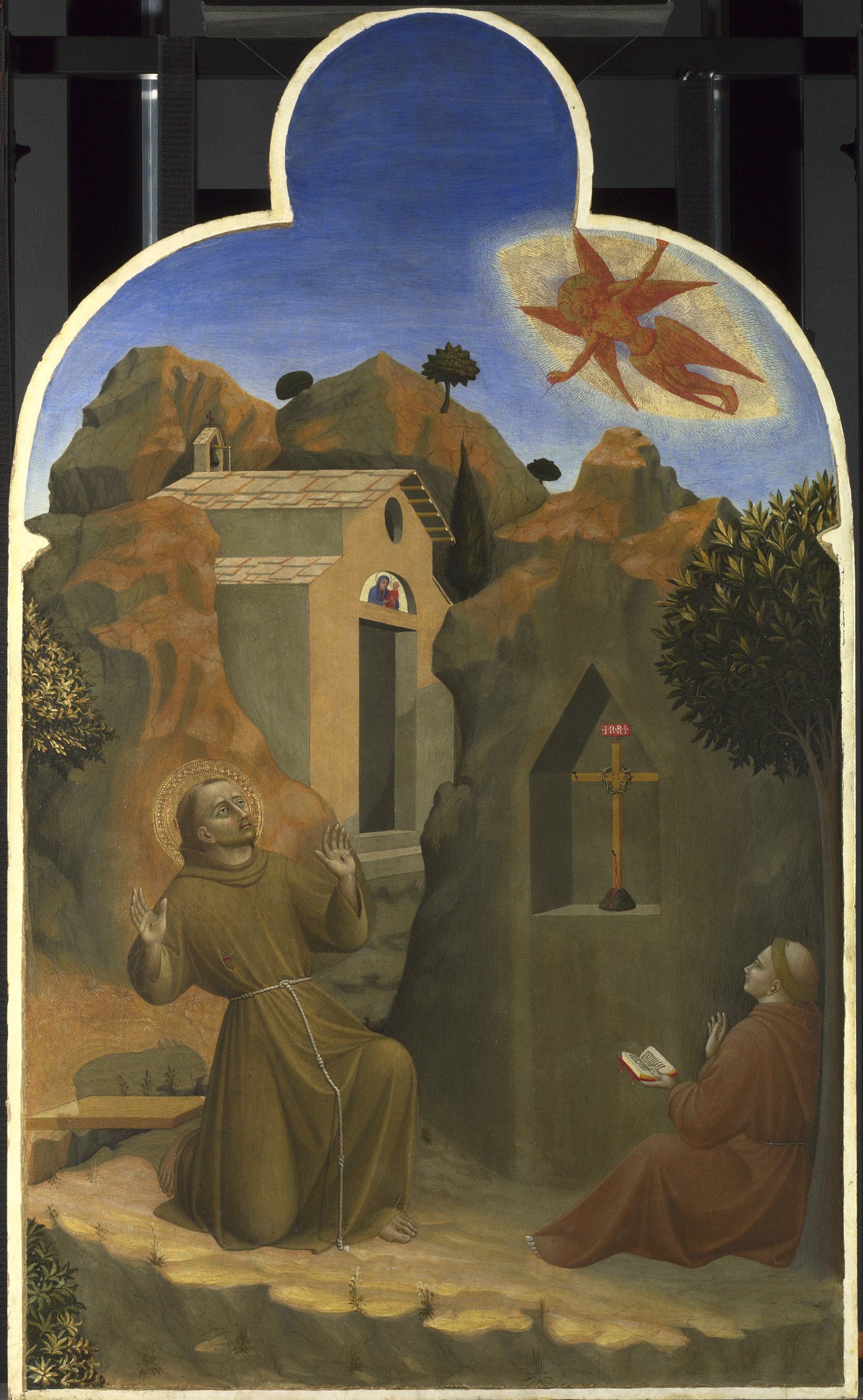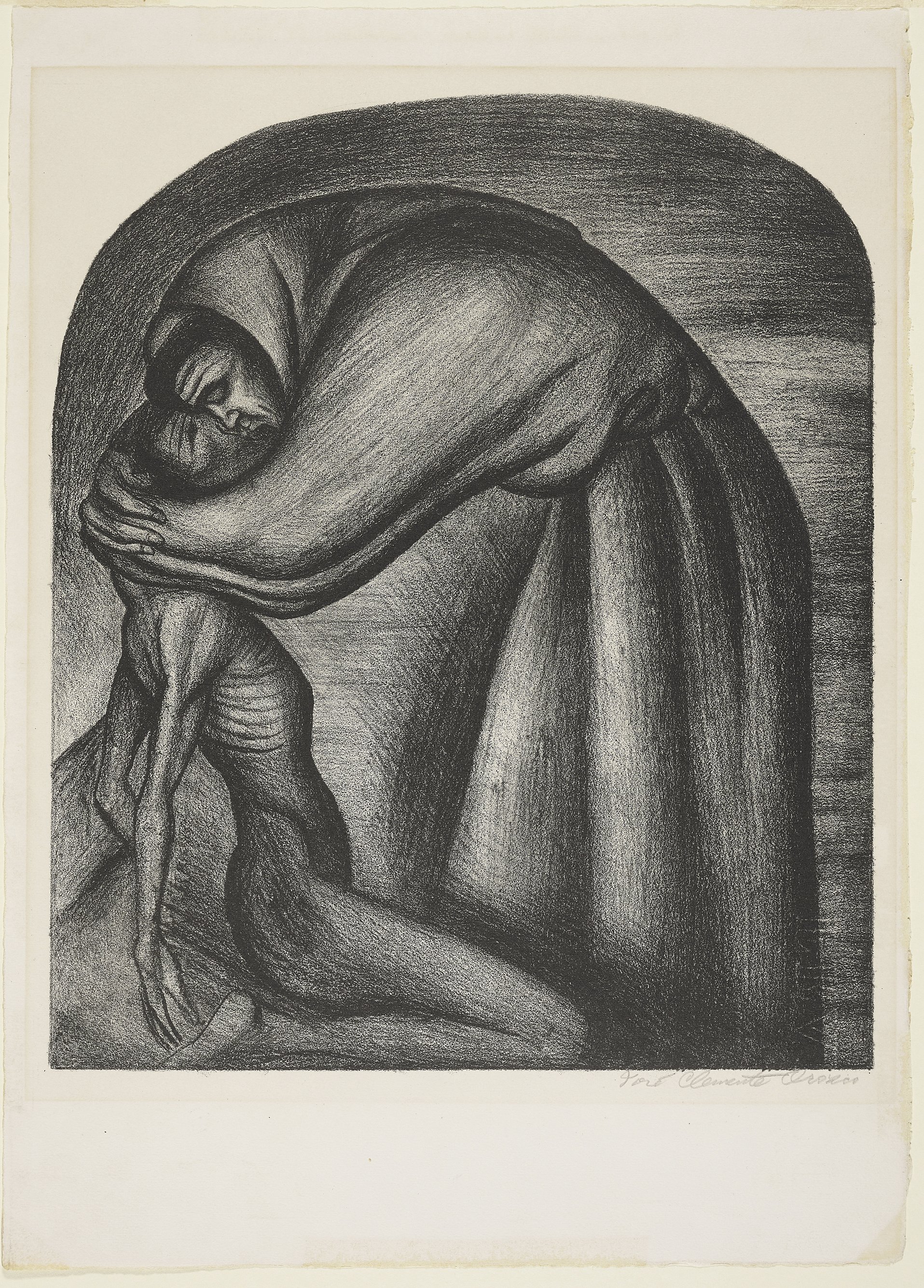St. Francis Of Assisi At The National Gallery in London


(REVIEW) LONDON — More books have been written about St. Francis of Assisi than virtually any other historical figure after Jesus Christ.
In the Italian town of his birth, he is even the subject of an entire bookstore. As this enthralling exhibition at The National Gallery demonstrates, the revered saint also captured the imaginations of artists who have for generations told his remarkable story without the need for words.
Born the son of a cloth merchant in Assisi circa 1181, this once “vain and arrogant” boy — according to his first biographer — famously renounced his family’s wealth to live an itinerant life of poverty in service to God. He preached the gospel to all who would listen (animals included), performed miracles and founded the Franciscan order, which has since spread around the world.
By the time Francis was canonized in 1228, just two years after his death, his image was already being spread across Italy. Giotto’s cycle of 28 frescoes in the Upper Church of the Basilica of San Francesco in Assisi inspired numerous artists, including the 15th century Sienese painter Sassetta. His exquisitely painted Borgo Sansepolcro Altarpiece, seven panels of which are exhibited here, is a vivid visual biography of Francis in which we see the saint rejecting his inheritance, taming a ferocious wolf, offering to walk through fire before the Sultan of Egypt and, most famously, receiving the “stigmata” — the wounds of Christ that were said to have appeared miraculously on his body in 1224.
Among the sources for these dramatic episodes are biographies by Thomas of Celano and St. Bonaventure and “The Little Flowers of St. Francis,” an anonymous compilation of writings that became a Christian classic. The veracity of these medieval legends is not questioned at The National Gallery — not that we should expect museums to argue for or against miracles, but it is interesting how these accounts are taken at face value in this nonreligious setting.
After the Council of Trent (1545-63) clarified the doctrine of the Catholic Church in response to the Protestant Reformation, images of Francis flourished with renewed vigor. Among a dynamic selection of counter-reformation canvases is El Greco’s 1590 depiction of Francis receiving the stigmata from mystical, enveloping clouds. Even more magnificent is Caravaggio’s tender 1595 portrayal of the saint collapsed in ecstasy and being comforted by an angel. But the grandest composition here is Murillo’s masterpiece, St. Francis Embracing the Crucified Christ (1668-9), a symbolic representation of the saint’s intense love for the savior.
Michelangelo Merisi da Caravaggio, 1571-1610, St. Francis of Assisi in Ecstasy, circa 1595-96. (Photo courtesy Wadsworth Atheneum Museum of Art, Allen Phillips)
Contemporary artists have also found much to admire in Francis. Antony Gormley’s “Untitled (for Francis)” (1985) takes the form of a full-body cast of the artist. Standing with outstretched hands in a pose inspired by Giovanni Bellini’s late 15th century painting “St. Francis in the Desert,” the lead and fiberglass figure has gaping holes in its hands, feet and chest. But this thoroughly modern Francis, bearing his wounds to all, forgets that the modest saint hid his stigmata from all but two of his most trusted brothers.
On an adjacent wall is “A Walk for Saint Francis” (2022) by Richard Long, an artist known for text-based works inspired by his epic walks. In May 2022, he spent eight days following in the saint’s footsteps, wandering alone on Mount Subasio above Assisi. A circle of 56 evocative phrases describe what he experienced along the way: lark song, distant bells, a starry night, white butterflies, the Umbrian plain.
José Clemente Orozco, 1883-1949, The Franciscan (El Franciscano), 1929 Lithograph, 58.2 x 40.5 cm. (Photo courtesy The Trustees of the British Museum)
In the accompanying circular wall painting “River Avon Mud Crescent” (2023), Long uses the humblest of materials — mud — spattered and smeared to evoke the form of the moon. It recalls Francis’ mystical hymn “Canticle of the Sun,” in which he praises God for the beauty of “Sister Moon” as well as “Brother Sun” and the variety of life on Earth. It’s refrain, “Laudato si” (Praise Be to You), was chosen as the title for the second encyclical of Pope Francis, urging the world to better care for the environment.
Long’s mud paintings would no doubt have appealed to St. Francis; so too the 1960s Italian art movement Arte Povera (literally “poor art”), whose artists channeled the Franciscan spirit by making their works with soil, rags, twigs and stones. One of its protagonists, Giuseppe Penone, is known for delicately carved sculptures excavating the interior of trees. In Door Tree — Cedar (2012), he carves a rectangular aperture into a huge, three-meter-high cedar trunk, revealing inside a slender sculpted sapling.
Penone’s tree stands at the center of a room dedicated to Francis’ engagement with the natural world — God’s creation — which for him was the greatest work of art. Here, we see him preaching to the birds in a contemporary woodcut by Andrea Büttner and greeting the sunrise in a panoramic Umbrian landscape by 19th century artist Giovani Costa.
The beauty he saw in nature spoke of the divine mandate to care for all of creation. No wonder, then, that he is the patron saint of animals and ecology. Indeed, Francis remains an inspirational figure for the modern world, with environmentalists, pacifists, social justice campaigners, revolutionaries, animal lovers and advocates of human solidarity all claiming him as their own. Even the current pope chose to identify himself with this saint for all seasons.
John Buscema Francis, Brother of the Universe, Marvel Comics, 1980. (Image courtesy Disney)
The broad appeal of Francis is exemplified by José Clemente Orozco, a prominent artist of post-revolutionary Mexico. His tender black-and-white print from 1926 depicting Francis holding an emaciated man recalls an episode from the saint’s life in which he embraced a victim of leprosy. Despite Orozco’s disdain for Mexico’s colonial history, he does not associate Francis with an oppressive religious presence but presents him as a deeply loving and compassionate figure.
This view of Francis was translated to the silver screen in the 20th century. In the exhibition’s final room, we are treated to excerpts from feature films including Liliana Cavani’s “Francesco” (1989), starring Mickey Rourke, and Franco Zeffirelli’s “Brother Sun, Sister Moon” (1972), with its memorable scene in which a disrobed Francis renounces his father’s wealth and vows a life of poverty, all in front of a shocked Bishop of Assisi.
Francis even stars in his own Marvel comic, “Francis, Brother of the Universe” (1980), which recasts him as a superhero. Here, his stigmata arrives on laser beams, shooting from Christ’s wounds, but he has no need of an updated costume — his brown habit, which appears again and again throughout the exhibition, is already iconic enough.
Francisco de Zurbarán pictures the tattered, patched-up garment in the extraordinary life-size portrait “St. Francis in Meditation” (1635-1639). Here, the saint is shown kneeling in a dark cell, clutching a skull and staring heavenwards, his face just visible from beneath his capuchin hood. Painted with an earthy materiality, the habit embodies the Franciscan ideals of poverty and humility, and though Francis is physically present, in spirit he seems transported to another realm.
A disheveled piece of sackcloth towards the end of the exhibition purports to be the genuine article, on loan from the Franciscans in Santa Croce, Florence. Said to have been worn by Francis himself, the crumpled habit is displayed — incongruously — in an ornate golden frame. It is cleverly juxtaposed with Alberto Burri’s “Sacco” (Sack) (1953), a mixed-media painting made from layers of weathered sackcloth and punctuated by a patch of blood-red paint — an evocation of Francis’s stigmata.
Horn with rods, 1219-1350, ivory, wood and silver support, 40 x 40 x 7 cm, Museo del Tesoro della Basilica di San Francesco, Assisi. (Photo courtesy the Sacred Convent of S. Francesco in Assisi, Italy)
Another extraordinary relic hangs nearby: a wonderfully preserved ivory horn that, according to tradition, was given to Francis in 1219 by the Muslim sultan of Egypt, al-Malik al-Kamil. Presented here as a symbol of cordial interfaith relations, the horn was used to gather people together to hear the saint preach.
These physical objects connect us to the time of St. Francis and his simple lifestyle. What, then, would he have thought about the wealth of material riches that his life inspired? That is the great paradox at the heart of this exhibition — that some of the world’s most valuable works of art have as their subject a man who espoused poverty and humility.
The poor, whom Francis loved, are so often excluded from blockbuster exhibitions such as this, which are relied upon by museums to swell their coffers. Remarkably, thanks to the generous support of donors — including Howard and Roberta Ahmanson — “St. Francis of Assisi” is free to all. The Franciscan spirit remains alive and well.
“St. Francis of Assisi” is on view at The National Gallery, London, until July 30. Visit The National Gallery website for more information.
David Trigg is a writer and art historian based in the U.K. He is the author of “Reading Art: Art for Book Lovers” and hosts the “Exhibiting Faith” podcast. You can find him on Instagram @davidtriggwriter.






